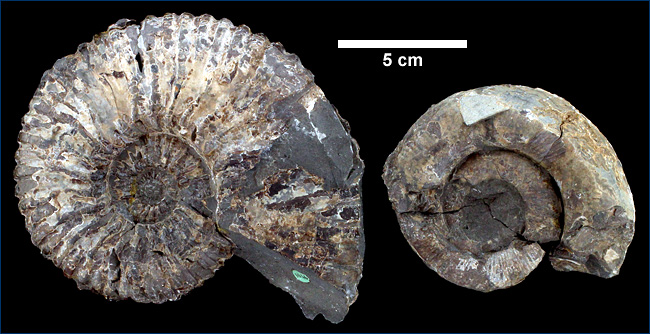
Ammonites from USGS Washington, DC, Locality 1066, Shasta County, CA, collected in 1893.
One ammonite at a time: Rehousing and digitizing the USGS Menlo Park collection
by Erica Clites
Work is well underway on what we refer to as the "USGS Project" — the rehabilitation of the orphaned US Geological Survey Invertebrate Collection from Menlo Park donated to UC and accessioned into the UC Museum of Paleontology in 1997. The project involves the rehousing and digitization of 100,000 invertebrate specimens and will take place in several phases.
 Ammonites from USGS Washington, DC, Locality 1066, Shasta County, CA, collected in 1893. |
During the past semester, four undergraduate students have been working up to ten hours a week rehousing the fossils into archival museum trays, updating and correcting earlier database records, and conducting research on the pioneering geologists and paleontologists who originally made this collection. The students have experienced firsthand the difficulties inherent to collections management: missing labels, overloaded drawers and difficult-to-read cursive handwriting. There is also the unexpected: the beauty of opening a drawer to discover a dense assemblage of brittle stars, bivalves identified by T.W. Stanton in 1893, or finding the 1974 correspondence between UC Berkeley alumnus Cliff Nelson and distinguished USGS paleontologist Warren Addicott (see a blog entry on this correspondence). Equipped with training and hands-on experience, these students will be well prepared to pursue future opportunities working with museum collections and collections management if they so choose.
This summer, two UCMP graduate students will reorganize the collections into the sixty, newly-installed and custom-designed cabinets at the UC Museum's Regatta Collections facility. The original USGS wooden cabinets housing the fossils were over fifty years old and due to multiple moves and less than ideal storage facilities prior to their transfer to UCMP, doors were missing and many drawers were not in their original location. The grad students will face the challenges of placing specimens in the appropriate cabinet, grouping fossils from the same locality, time period or formation. This often requires additional research and a bit of "puzzle-solving" and undoubtedly will also reveal additional unexpected mysteries from this historically-rich and scientifically significant collection.
Also as part of the project, students and UCMP volunteers, Don Pecko and Kathy Zoehfeld, have begun photographing the oversized USGS specimens, especially the spectacular ammonites. Our very talented and dedicated volunteer photographer, Dave Strauss, adapted a copy stand to accommodate a digital SLR camera purchased on the NSF grant. In addition to photographs of individual fossils, a virtual view of the inside of each drawer will be documented by photographing trays of specimens from every locality. The photographs will be accessible through CalPhotos and linked from associated data in the UCMP database.
What else is on the horizon for the USGS collection? All localities will be added to the UCMP database, allowing new archival labels to be printed and placed with the fossils. As this effort proceeds, we expect an increase in access for research, teaching, and outreach — and this is what UCMP encourages. Even in its earlier nearly inaccessible state, the USGS collection was important in a variety of research areas: hydrothermal vent paleoenvironments, deep sea whale-fall communities, systematic studies, and geological mapping applications. Making site information and photographs available online will encourage even further research.
Periodically check CalPhotos to see new photographs taken by our team of students and volunteers. By the end of the project, everyone will be able to see the results with the click of a mouse!
All photos by the UCMP Invertebrate Collection crew